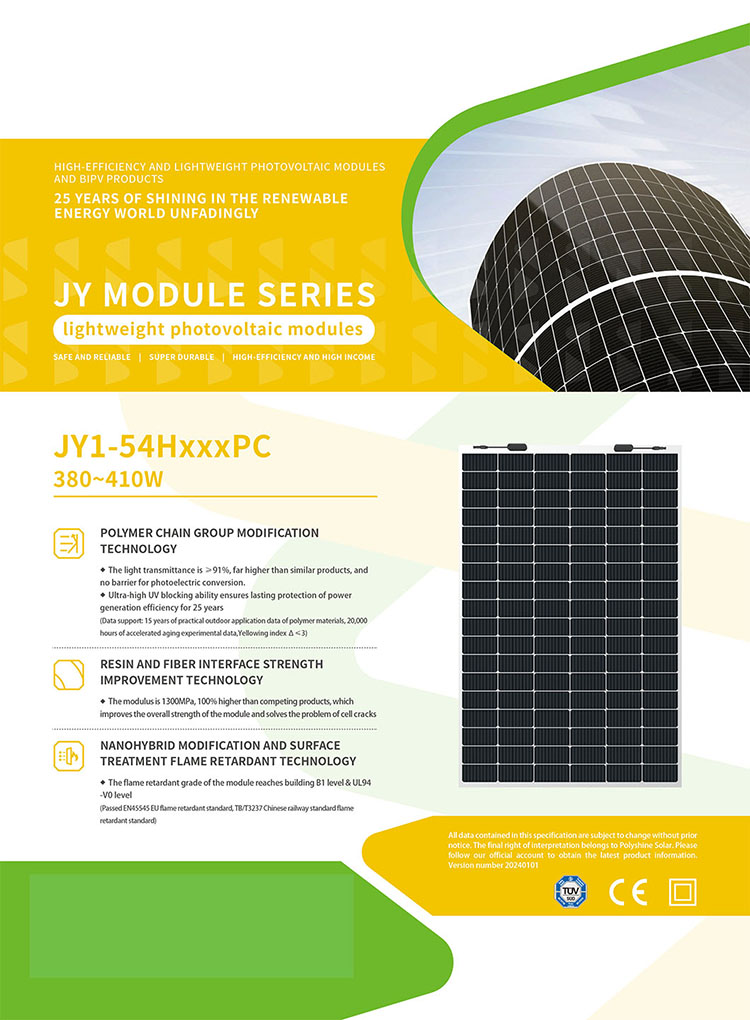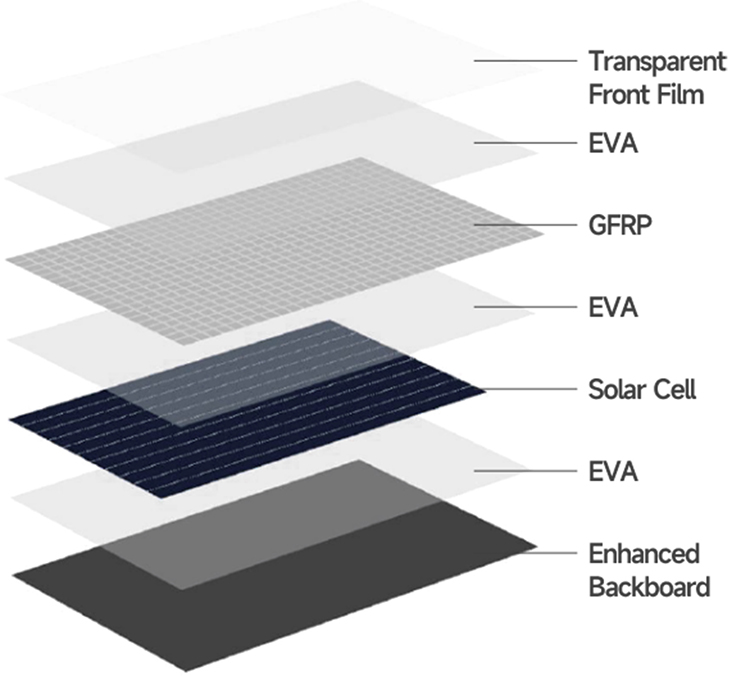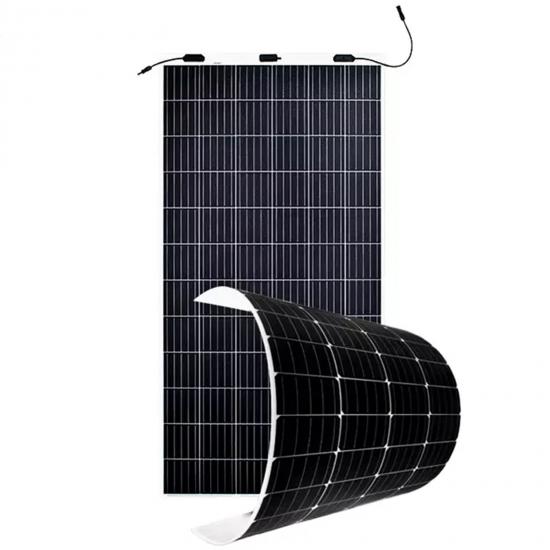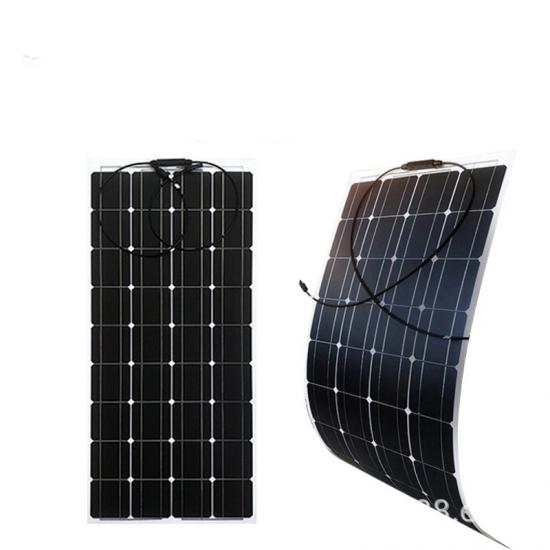
PARAMETER
|
TYPICAL ELECTRICAL CHARACTERISTICS |
|||||||||
|
AT STANDARD TEST CONDITIONS(STC) |
STC:AM=1.5,irradiance1000W/m²,Component temperature25ºC |
||||||||
|
Typical Type |
Unit |
JY1-54H380PC |
JY1-54H385PC |
JY1-54H390PC |
JY1-54H395PC |
JY1-54H400PC |
JY1-54H405PC |
JY1-54H410PC |
|
|
Max-Power(Pm) |
W |
380 |
385 |
390 |
395 |
400 |
405 |
410 |
|
|
Power Tolerance |
W |
|
|
|
0~+5W |
|
|
|
|
|
Max-Operating Voltage(Vm) |
V |
30.23 |
30.38 |
30.54 |
30.69 |
30.85 |
31.02 |
31.18 |
|
|
Max-Operating Current(Im) |
A |
12.59 |
12.69 |
12.79 |
12.89 |
12.99 |
13.08 |
13.17 |
|
|
OpenCircuitVoltage(Voc) |
V |
36.00 |
36.20 |
36.40 |
36.60 |
36.80 |
37.00 |
37.20 |
|
|
Short Circuit Current(isc) |
A |
13.42 |
13.49 |
13.56 |
13.63 |
13.70 |
13.76 |
13.82 |
|
|
Module Efficiency(nm) |
% |
19.2 |
19.5 |
19.7 |
20.0 |
20.2 |
20.5 |
20.7 |
|
|
ELECTRICAL CHARACTERISTICS AT NOMINAL MODULE |
NMOT:irradiance 800W/m,ambient temperature20ºC,wind speed1m/s |
||||||||
|
Typical Type |
Unit |
JY1-54H380PC |
JY1-54H385PC |
JY1-54H390PC |
JY1-54H395PC |
JY1-54H400PC |
JY1-54H405PC |
JY1-54H410PC |
|
|
Max-Power(Pm) |
W |
286 |
290 |
294 |
298 |
302 |
306 |
310 |
|
|
Max-Operating Voltage(Vm) |
V |
28.09 |
28.24 |
28.42 |
28.55 |
28.70 |
28.85 |
29.00 |
|
|
Max-Operating Current(m) |
A |
10.21 |
10.30 |
10.39 |
10.47 |
10.55 |
10.62 |
10.71 |
|
|
Open-Circuitvoltage(Voc) |
V |
33.80 |
34.00 |
34.20 |
34.40 |
34.60 |
34.80 |
35.00 |
|
|
Short-circuit current (Isc) |
A |
10.70 |
10.77 |
10.85 |
10.90 |
10.96 |
11.01 |
11.08 |
|

ADVANTAGE
Traditional modules cannot meet the needs of modern photovoltaic integrated buildings in terms of lightweight, flexibility, functional integration, and overall performance.
·Limited Load heavyweight, bracket installation, high roof load requirements
·Safety Risk risk of self-explosion (3‰ )
·Additional costs steel structure/bracket costs, labor costs due to complex construction
·Insufficient Shock Resistance the glass module is fragile and has poor shock resistance
·Aesthetic Shortcomings single color, single shape, poor adaptability
·LIGHTEROnly 30% of the weight of traditional modules, solving the problem of insufficient load on existing roofs
·MORE FLEXIBLEIt can be better integrated into architectural design, provide more diverse appearance and integration solutions, and adapt to different curved surfaces and shapes, so that photovoltaic systems can be perfectly integrated with buildings and reduce design restrictions.
·SHINING GREEN ENERGY WORLD Through the research and technological iteration of encapsulation materials, we have solved the insufficient light transmission and weather resistance of other ordinary lightweight modules and achieved higher and more stable power generation efficiency.
Flexible solar panels differ quite from rigid, rectangular, glass-encased standard solar panels typically found on rooftops. Rather, flexible solar panels come in all shapes and sizes and are expected to be used in a greater number of situations than standard panels Whereas portable solar panels contain solar cells mounted in a lightweight, often plastic frame and thin-film panels are made of materials like copper, selenium, and gallium, flexible and standard solar panels use solar wafers to convert sunlight to electricity. Most often, flexible panels use wafers made from silicon, though they are far thinner than those in standard panels-as thin as merely a few micrometers in width. Whereas standard panels are sandwiched between layers of glass, flexible panels are placed between layers of protective plastic.
Flexible solar panels differ quite from rigid, rectangular, glass-encased standard solar panels typically found on rooftops. Rather, flexible solar panels come in all shapes and sizes and are expected to be used in a greater number of situations than standard panels Whereas portable solar panels contain solar cells mounted in a lightweight, often plastic frame and thin-film panels are made of materials like copper, selenium, and gallium, flexible and standard solar panels use solar wafers to convert sunlight to electricity. Most often, flexible panels use wafers made from silicon, though they are far thinner than those in standard panels-as thin as merely a few micrometers in width. Whereas standard panels are sandwiched between layers of glass, flexible panels are placed between layers of protective plastic.
The Lifepo4 battery power bank is Lithium iron phosphate battery module which designed for backup power application. This battery module integrated with intelligent BMS inside, has big advantages on safety, cycle life, energy density, temperature range and environmental protection. Model: 51.2V 100AH or 48V100AH Rated Voltage (V): 51.2V/48V Rated Capacity (Ah): 100Ah Supply Ability: 5000 per Month MOQ: 1pc Certificate: CE, IEC62619, UN38.3, MSDS,ISO9001
The 60kw off grid solar system is suitable for area without grid or grid is not stable. It can be compatible with generator or grid. Inverter power: 60kw power frequency inverter AC output voltage: AC120V/240V split phase or three phase 208V/380V Battery voltage: DC360V Battery type: Gel battery or LiFePO4 battery Solar panel type: Mono or poly
Characters Max 97.8% efficiency Real time precise MPPT algorithm for max harvest Wide input voltage operation range Outdoor install protectio due to IP65 LCD Screen makes simple and clear showing Easy installation and maintenance due to“Plug & Play”connection Interface selection-Wi-Fi/GPRS Built in zero export function(optional) Rust-free aluminum covers Flexible monitoring solution Intelligent grid management Reactive power capability Self power reducer when over frequency Remote active/reactive power limit control Component brand Specification Model No ST1000TL ST1500TL ST2200TL ST3000TL ST3600TL ST4400TL ST5000TL ST6000TL DC side/Input parameters Max. DC power [W] 1200 1800 2500 3400 3680 4500 5500 6000 Max. DC voltage [Vdc] 450 450 500 550 Min. System start voltage [Vdc] 75/150 75/100 MPPT voltage range[Vdc] 100-450 100-450 100-500 100~550 Max. input current [A] 10 10 13 15 13.5/13.5 13.5/13.5 15/15 15/15 Number of MPP trackers 1 2 Strings per MPP tracker 1 AC side/output parameters Nominal output power [W] 1000 1500 2200 3000 3300 4000 4600 5500 Maximum output power [W] 1100 1650 2420 3300 3680 4400 5000 6000 Nominal output voltage/range [V] 208,220,230,240/180~270 AC grid frequency/range [Hz] 50Hz,60Hz(auto-selection) / 44Hz-55Hz; 54Hz-65Hz Maximum output current [A] 6 8 12 17 16 21 23 26 AC connection(with PE) Single phase Current distortion(THDi) [%] <1.5 <2.5 Power factor [%] ~1(Adjustable from 0.8 leading to 0.8 lagging) Efficiency Maximum conversion efficiency[%] 97.3 97.3 97.4 97.5 97.8 97.5 97.6 European efficiency[%] 97 97 97.1 97.2 97.3 97.2 97.3 MPPT efficiency[%] 99.9 Safety and protection 99.9 DC reverse-polarity protection yes Anti-islanding / Overvoltage protection yes Short circuit protection yes Leakage current protection yes Grid monitoring / Ground fault monitoring yes DC/AC side varistors(thermally protected) yes General Parameters yes Dimension(L/W/H)[mm] 382*317*151 382*317*166 Weight (kg) 10 13.5 Embedded DC Switch Optional Night power consumption[W] <0.2 Isolation type Transformerless Protection degree IP65 according to IEC60529 Operation temperature[ºC] -25 ~ 60 Cooling concept Natural convection Acoustic noise level[dB] <25 Operating altitude[m] <2000 without power derating Display Graphic LCD Communication Interface Standard WIFI; GPRS(optional) Certificates and Approvals CE-(EMC/LVD) : EN(IEC) 61000-1/-2/-3/; EN(IEC) 62109-1/-2;IEC 61727/62116;G83-3/G59-3; EN50438;VDE-0126-1-1;VDE-AR-N4105;AS4777.2;AS4777.3 Project
Characters Transformerless with three level topology Max efficiency up to 98.6% Dual MPPT inputs accommodating wide voltage range Compact structure design Complete protection function such as anti-islanding, short circuit, overload Easy installation and free maintenance WiFi or GPRS (optional) communication
Off-grid solar energy systems are also called stand-alone solar systems. It does not connect with Grid or called Utility. It is very popular and suitable for remote areas where there is no public power or Public power is instable. It can be for Home applications, Commercial applications and Industrial applications. Inverter power: 3kW AC output voltage: AC110V/120V Battery voltage: DC24V or DC48V Battery type: Gel battery or LiFePO4 battery Solar panel type: Mono or poly Compatible with grid and generator Monitor: WIFI or GPRS
The LiFePO4 battery ESS (Energy Storage System) includes LiFePO4 battery, PCS. The system includes 100KWh LiFePO4 battery, 50KW PCS, liquid cooling system and Fire protection system. The system includes BMS, PCS, and EMS.


 IPv6 network supported
IPv6 network supported











